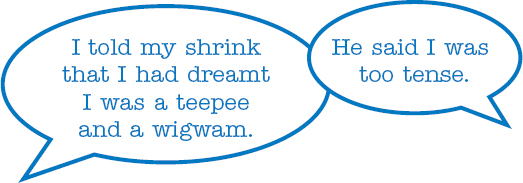
How and what to do.
SO YOU’RE IN A TOUGH RELATIONSHIP WITH ENGLISH—LET’S TALK ABOUT THAT!
Maybe you’ve tried to pick up an American accent before and it made you uncomfortable. Maybe your family thinks that you shouldn’t change. Maybe you’ve tried and failed, and now you’re frustrated. Whatever the reason, you’ve got an unsatisfying relationship with English. We’re here to fix that.
Let’s Get Your Head in the Right Place
Learning a whole language is indeed a big deal, but you’ve already done all the heavy lifting, having learned the grammar and vocabulary. Right now, we’re just doing the fine-tuning and working on your accent. Here’s what you should expect after the first 1–6 weeks (depending on your diligence).
There are two ways to pick up the accent—All at once or step by step
There’s the do-it-now people and the people who like to change slowly, thinking that there is no validity to things that happen quickly to them. People don’t think it’s real if it’s fast. But that’s the Nike® slogan: “Just do it!” You know you can, and even if it is faster than you expect, it’s still valid. It’s all about behavior modeling. You don’t have to believe it, you just have to do it.
All at Once
Just do it! Listen to the sounds and rhythms. Capture some essential elements and go!
Step by Step
Apply each technique one by one to develop your voice quality, pronunciation, intonation, phrasing, and linking. After you have mastered each of these elements, work on integrating them into speech.
Which method will work best for you? We’ll try the all-at-once way first to see if we can jumpstart you with this shortcut. This isn’t so much about the American accent as much as it’s about your doing pure mimicry. Don’t think. Don’t overanalyze. Just imitate exactly what you hear in every aspect—voice quality, pronunciation, rhythm, phrasing, and wordflow.
Review Exercise 1: Pure Mimicry |
Listen to this heavy Australian accent, record yourself, and compare the two.
Please call Stella.
When comparing your recording with our Aussie friend, see if you copied his nasality, used plays for the pronunciation of please and included the distinctive phrasing as he finishes up the sentence. If your recording matches closely and you were comfortable with the process, get started. If it wasn’t entirely satisfying for you, or your recording didn’t sound like him, let’s take a moment to think about who you are and how you learn best.
Review Exercise 2: Are You Steadfast or Freewheeling? |
Answer the following questions with a checkmark in the appropriate box.
1.Would you rather answer . . .
 An essay question
An essay question
 A multiple-choice question
A multiple-choice question
2.Do you . . .
 Start from yes
Start from yes
 Start from no
Start from no
3.Do you prefer solutions that are . . .
 Open-ended, abstract, and subject to interpretation
Open-ended, abstract, and subject to interpretation
 Clear-cut, precise, and objective
Clear-cut, precise, and objective
4.Are you . . .
 Comfortable with a flexible time frame with constant updates
Comfortable with a flexible time frame with constant updates
 More deadline oriented
More deadline oriented
5.Do you prefer to . . .
 Follow another person’s lead
Follow another person’s lead
 Do things your own way
Do things your own way
If you selected the second option two or more times, try this experiment. Just for today, when someone says something to you, practice temporarily suspending judgment. Respond with, “Hmm, that’s interesting,” “Tell me more,” or “You could be right.” Not only will this help you listen better, but it will also make you a better conversationalist and open your mind to picking up and using this accent.
Review Exercise 3: Mimicry |
Say the following sentence out loud:
There was a time when people really had a way with words.
Did you say it out loud (not to yourself, actually out loud)? If you did, go on to the next exercise. If not, let’s talk about why you didn’t. As we all know, stubborn is a negative word, and nobody wants to attribute a negative word to himself or herself. As the famous curmudgeon Bertrand Russell said, “I am firm. You are obstinate. He is a pig-headed fool.” Interestingly, stubbornness has both positive (consistent, reliable, persistent) and negative (stubborn, inflexible, rigid) aspects.
Think back in your life to a time when persistence paid off. It may have been following through on an idea to successful fruition or overcoming apparently insurmountable odds on something important to you. Own that—it’s yours. One of my favorite responses was when I asked a successful businessman if he’d had everything handed to him, if building his business had been easy, or if he’d had to fight to succeed. “Fight?!” he barked, “I’ve had to kill!”
Now, however, we’re going to look at how stubbornness can get in your way. Stubbornness isn’t necessarily something that just happens later in life, but is often an innate trait. Many of us have a deep-seated feeling of what is right, and it’s hard to go against this. If you’re a visual learner, chances are you did well on spelling tests, and so you have a sense of the rightness of spelling. It can be checked and validated. Speech, however, may seem very fluid and freeform to you. For this process, however, you need to embrace the rightness of phonetic spelling for speech as much as you embrace the rightness of spelling for written English and the rightness of mathematical notation for numbers.
Sometimes you’re not being stubborn—you really do forget because you’re focusing on what you’re saying instead of how you’re saying it. To illustrate this, a researcher had a problem with the door of the lab refrigeration unit, whose tall, upright handle had come loose. Not having time to fix it, he decided to open it by pulling on the side. Not five minutes later, he went back to grab some more vials and opened the fridge with the handle. It came completely loose and clonked him on the head! This time, he knew he had to remember, so he put a note right on the handle to remind himself. And again, a few minutes later, when he went back to get another vial, he grabbed the handle and hit himself on the head again. Clearly he needed a more dramatic solution. He took a whole page of newspaper and covered the entire handle of the fridge, so that the next time he mindlessly grabbed the handle, the newspaper crackled, and he realized what he was about to do. It’s not like he wanted to get hit in the head, he just kept forgetting because he was focused on the goal and not the process. Sometimes people speaking English are so focused on the end product of using words in conversation, like he was in the end product of getting vials out of the fridge, that they forget to include the accent and pronunciation.
THINK, THEN ACT
When you have learned the techniques, but forget to apply them in speech, you are acting before thinking. In order to train yourself to think first, devise a strategy that works for you. For the researcher, it was putting a sheet of newspaper over the fridge handle. For you, it might be taking a deep breath before speaking, counting to three, pulling on a rubberband, or even the old school standby—a string around your finger. The point is, while you are internalizing these new sounds and rhythms, to create a stopgap measure to get you to focus on the process and not so much the goal.
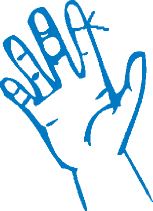
THE FOUR STAGES OF LEARNING
Let’s look at the transition you’re going to be going through.
1.Unconscious incompetence (you don’t even know you’re making mistakes).
2.Conscious incompetence (you’re aware, but you don’t know how to fix them).
3.Conscious competence (when you focus really hard, you’re actually pretty good).
4.Unconscious competence (you’ve internalized the concepts, and it’s second nature).
You’re most likely edging from 2 to 3. To get to 4, the key is consistent practice—a minimum of fifteen minutes per day, plus applying the techniques whenever you talk.
Review Exercise 4: Correlating Sounds & Phonetic Transcription |
Listen to this sound and correlate it with this phonetic transcription:
gäddit
Repeat this sound and notice the open ah sound of gä, the way the tip of your tongue flicks on the bumps on the top of your mouth, and the fact that the air doesn’t pop out at the end of the word. Listen to the audio and say this out loud ten times.
Review Exercise 5: Correlating Phonetic Transcription & Regular Spelling |
Listen to this sound and correlate it with this phonetic transcription:
gädditGot it!
Using the exact same sounds as before, observe how different the spelling is. Listen to the audio and say this out loud ten times.
SKIDIZ
Let me tell you a little story about how I came to “get” word connections in French, or, as they like to call them, liaisons. I stumbled upon the word skidiz and was amazed that it could represent ce qu’ils disent. “Wow! That looks different!” I thought to myself. “They’ll never understand me if I say it like that.” Fortunately, my empirical side prevailed and I thought, “Okay, fine, I’ll try it, even if it’s just to prove that it doesn’t work.”
I was in Marseilles, so I combined it with the local pronunciation of Je ne sais pas, and managed to work Sheh pah skidiz in as a conversational response. Whoa! To my huge surprise, it worked, and the person started talking to me in real French and not baby language. That led me to part two of the epiphany: “Yikes, if I do this, it’ll totally raise their expectations of how well I speak,” and then, “Ahh, I’m talking the way I want them to talk to me, so I can understand them more easily!”
Once I realized how I’d been sabotaging myself, I started trusting the phonetics and stopped basing my pronunciation on spelling. My confidence went up because thought follows behavior, and my new behavior resulted in more sophisticated, intelligent conversations. People didn’t have to talk down to my language level, but could actually talk with me at my conversational level. It’s my goal that you have that same realization with gäddit. My job is to give the epiphany. Your job is to hold on and use it.
Review Exercise 6: Gathering That Empirical Evidence |
Trusting in this method is an important component of how successful you will be, so we’re going to do a short trust exercise. Take this phrase out into the world and use it exactly the way it’s presented here. Try it out on coworkers and friends. Watch how they respond to you now that they can hear you playing with the language a little.

Play with the sounds, rhythms, and patterns. Have fun! You’ll find that some of the inhibitions fall away and your linguistic adaptibility kicks in.
PHONETIC TRANSCRIPTION = MATHEMATICAL NOTATION
If you accept that 2 × 2 can also be written 22, you are comfortable with multiple labels for a single concept. This is the same principle as the word cat also being written as kæt.
Here is a simple two-part rule for the letter O:
1.In a one-syllable word, o sounds like ä (unless the word ends in e): hot, lost, Tom, Bob, dot com |
2.In a stressed syllable, o also sounds like ä: possible, Holland, philosophy |
Here is a two-part rule for the letter A:
1.In a one-syllable word, a sounds like æ (unless the word ends in e): cat, Sam, drab |
2.In a stressed syllable, a sounds like æ: rational, manager, catastrophe |
(For more on these two vowels, see Chapter 3.)
Once you have internalized the basic rules of phonetics, you need to diligently, persistently, and stubbornly apply them universally. In computing terms, think of doing a global Search All and Replace.
Some people have an initial aversion to reading phonetics because it’s new and confusing.
It doesn’t even look like English! This is where we’re going to have you practice some of that open-mindedness and trust. Accept that if you read the phonetics, you will have an American accent.
An accountant kept making the same pronunciation errors in English over and over again. Asked why, her response was consistently, “I forgot!” When asked if she forgot arithmetic, the answer was, “Of course not, that would make my life miserable.”
Well, not applying the phonetics was making her life miserable!
OVERCONFIDENCE
Counterintuitively, it’s sometimes overconfidence that gets in a person’s way. You’re used to the positive rewards of doing things quickly and independently—an algebraic equation, a sales report with a high closing rate, a dissertation. Because you’re good at what you do, you can skip over certain details. However, if you try to rush through speaking English, you’ll end up skipping crucial details. Furthermore, if you only rely on your own judgment about your accent, particularly if it’s spelling based, you’re going to fall far short of the mark.
What to do about it? Start from scratch and make a conscious effort to get rid of your preconceptions. Put yourself in the position of knowing nothing about pronunciation, intonation, voice quality, word connections, etc. Then, lay the foundation with basic sounds and rhythms. Rebuild a new strong structure using the grammar and vocab you’ve worked so hard to acquire.
THE “WHAT” FACTOR
Let’s do a quick assessment of what other people think of your accent. How often during a day does someone ask you to repeat yourself? How long does it take to give your email address, and how many times do you have to spell your name? That’s your “What?” factor. But the real question is, how does this affect you? How does it affect your working situation, your home life, your life as a whole? Does it make you feel discouraged, or does it encourage you to change? Or does it make you feel like everyone else needs to change around you? Let me tell you a story about someone who felt this way. We’ll call her Mei Li.
A Chinese professor was studying English in the United States, and her instructor had suggested that, for convenience, she Americanize the pronunciation of her name, and she flew into a rage. She excoriated him in a long email about how disrespectful this was to 5,000 years of her Chinese ancestors. The American instructor was stunned and passed her on upstairs.
The senior instructor set about finding out what was going on. To say Dr. Li was linguistically rigid is a profound understatement. The instructor would ask, “But let’s say you’re at the DMV. The clerk doesn’t know from Chinese ancestors. Don’t you just want him to catch your name the first time and to process the transaction?” “No!” she would declare. “It’s my name!”
The instructor finally told her that they simply had to make a breakthrough, so her entire homework would consist of leaving a voicemail with her name Americanized so it would be easier to understand by any random person. She left eight to ten identical Chinese-sounding attempts. Finally, she left one that started with a deep sigh and a deeper voice, “My name is Mei Li.” It was a thing of beauty. Unfortunately, 30 seconds later, she left another very nasal one, “My name is Mei Liiiiiiiiiiiiiiii!”
Go On, Change Your Name
No, not permanently or legally, but get comfortable with saying your own name differently than you have for your entire life. It may feel weird, unreal, surreal, or just plain dumb, but it’s an invaluable mental exercise. Every time that I landed in a new country, my first order of business was to find out who I was, or at least how my name was pronounced. I went from Madrid (Me llamo Anita), to Paris (Je m’áppelle Annie), to Tokyo 
DROP THE BAGGAGE!
For a lot of people, the American accent comes with a lot of emotional baggage. Americans are loud! Emotionally immature! Unsophisticated! It may be conflicting for an educated sophisticate such as yourself to work toward actually sounding like this. But you need to fit in and be understood, so drop off the baggage. Just focus on the pure sounds.

Emotional Investment in Particular Sounds
A man with a distinctly Spanish accent had trouble distinguishing iPod from iPad. He learned the æ sound for iPad, but didn’t extrapolate that sound to other words, such as cat, laugh, or dance. It would be natural to think that he simply didn’t know where to use it. But surprisingly, when asked why he didn’t use the æ sound, he laughingly responded, “Because I hate it.”
Some people have a strong identification with their pronunciation, considering it part of their identity or personal brand. They may reject a single sound or the entire accent. Unless the change wells from within, the accent won’t take root and become a true part of them.
Motivation

Sofia Vergara, a Colombian actor in the American sitcom Modern Family, was doing an interview, explaining that her 21-year-old son had seen a video of her many years earlier and said, “Mom, you’re the only person who’s come to America and your accent got worse!” Her utterly charming response was, “It’s the moh-nee, I don’t have to do eet anymore!” In another interview, Oprah Winfrey asked why her accent seems to be getting heavier, even though she’d been living in America for some time. Sofia explained that she actually does it for comedic effect: “I realized that sometimes it was funnier to say YOOOUHH rather than you.” She’s very self-aware and has excellent reasons for maintaining her brand.
Over the years, however, we’ve heard pretty much every excuse from people who have demonstrated that they are able to create the sounds in isolation, but don’t go on to the next step of universally applying the rules.
I feel uncomfortable. |
It’s not possible. |
I tried and can’t. |
I don’t understand the rules. |
Why should I have to? |
It’s not “right.” |
I wasn’t thinking about it. |
It makes me sound arrogant. |
I forgot. |
I was focusing on what I was saying. |
People will laugh at me. |
I was rushing. |
DOES PRONUNCIATION REALLY MATTER?
People say, It’s just a detail . . . does it really matter? Isn’t “okay” good enough for what’s needed and not worth the effort of going to the next level? We don’t have that sound in my language, and we communicate just fine without it. This may be true, but if you’re, let’s say, a doctor, don’t you want your patients to know the difference between your saying, “He’s in urology” and “He’s in neurology” or “We did a below-knee amputation” and not “We did a baloney amputation”? So yes: Pronunciation matters!
Go to Extremes
As an exercise, we have people put on a caricature of an American accent, and generally it’s quite accurate. They are reluctant, however, to use it because of the inherent mockery involved. It’s okay! I can assure you that Americans won’t even notice when you’re putting on a super heavy American accent . . . . They’ll just think your English got better.
Your family and friends may react negatively and make fun of your nascent attempts to modify your speech. They like you the way you are. They may think your accent is cute. They may think that if you change how you talk you may change who you are. The bottom line is that you will sound different, and they may not like it.
We recommend practicing on strangers. They don’t have a baseline and can accept you at face value. At this point, it may be hard for you to conceive how differently you will be treated. A lot of Americans, I regret to say, turn off when they hear a foreign accent, or are less than kind. Since we can’t change all of them, we can make a small change in you.
Your Own True Voice
There is not, of course, just one American voice, even for one person. People associate their voices with themselves, but have many different voices throughout their lives. You have a different voice as a child than as an adult, different in business than at a party, and so on.
Stephen Hawking, the British astrophysicist, had an English accent prior to the paralyzation of his vocal cords. After using a robotic voice with an American accent, he came to associate himself with that voice. Several years later, when production of the DECtalk DCT01 voice synthesizer was discontinued, he declined to switch to a model with a British accent. He identified with the American voice and associated it with himself. “I would not want to change, even if I were offered a British-sounding voice. I would feel I had become a different person,” he said.
7 STEPS TO A PERFECT ACCENT
1.Yep, I have an accent, I want to change it, and I’m sure this program will work for me.
2.I’m making a conscious effort to apply the techniques in an orderly, step-by-step manner.
3.I have taken an inventory of the sounds and rhythm patterns.
4.I am keeping a daily log of the What Factor.
5.I record myself once a week, compare it with my original recording, and take specific and detailed notes of changes.
6.When I talk to people, I consciously and conscientiously apply the techniques.
7.I read aloud for 15 minutes a day with a phonetic transcription or imitate an audio text.
The Pledge
“It’s not the duration, it’s the consistency. I’m training my mouth, lips, tongue, and mind.”
REVIEW AND EXPANSION
In the first nine chapters of the American Accent Training program, we covered the concepts that form the basis of American speech—intonation, word groups, the staircase, and liaisons, or word connections. We also discussed some key sounds, such as æ, ä, and  (Cat? Caught? Cut?), the El, the American T, and the American R. Let’s briefly review each item.
(Cat? Caught? Cut?), the El, the American T, and the American R. Let’s briefly review each item.
Intonation
You’ve learned some of the reasons for changing the pitch (or saying a word louder or even streeetching it out) of some words in a sentence.
1. To introduce new information (nouns)
2. To offer an opinion
3. To contrast two or more elements
4. To indicate the use of the negative contraction can’t
For example: |
|
New information |
Opinion |
He bought a car. |
It feels like mink, but I think it’s rabbit. |
Contrast |
Can’t |
Timing is more important than technique. |
He can’t do it. |
You’ve also learned how to change meaning by shifting intonation without changing any of the actual words in a sentence.
I applied for the job (not you!).
I applied for the job (but I don’t think I’ll get it).
I applied for the job (not I applied myself to the job).
I applied for the job (the one I’ve been dreaming about for years!).
I applied for the job (not the lifestyle!).
Miscellaneous Reminders of Intonation
When you have a verb/preposition combination, the stress usually goes on the preposition: pick up, put down, fall in, and so on. Otherwise, prepositions are placed in the valleys of your intonation. It’s f’r you., They’re fr’m LA.
When you have initials, the stress goes on the last letter: IBM, PO Box, ASAP, IOU, and so on. (See also Chapter 1.)
Liaisons and Glides
Through liaisons, you learned about voiced and unvoiced consonants—where they are located in the mouth and which sounds are likely to attach to a following one. You were also introduced to glides. (See also Chapter 2.)
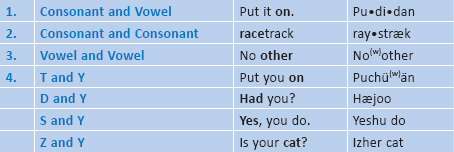
Cat? Caught? Cut?
This lesson was an introduction to pronunciation, especially those highly characteristic sounds, æ, ä, and  . (See also Chapter 3.)
. (See also Chapter 3.)
æ |
The jaw moves down and back while the back of the tongue pushes forward and the tip touches the back of the bottom teeth. Sometimes it almost sounds like there’s a Y in there: cat kyæt. |
ä |
Relax the tongue; open the throat like you’re letting the doctor see all the way to your toes: aah. |
|
This sound is the sound that would come out if you were pushed (lightly) in the stomach: uh. You don’t need to put your mouth in any particular position at all. The sound is created when the air is forced out of the diaphragm and past the vocal cords. |
The American T
T is T, a clear popped sound, when it is at the top of the staircase.
•at
at the the beginning of a word, table
•in a stressed syllable, intend
•in ST, TS, TR, CT clusters, instruct
•replaces D after unvoiced consonants, hoped hopt
T is D, a softer sound, when it is in the middle of the staircase.
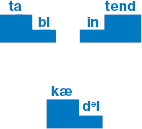
•in an unstressed position between vowels, cattle caddle
T and D are held (not pronounced with a sharp burst of air) when they are at the bottom of the staircase.
•at the end of a word, bought bä(t)
T is held before N.
•unstressed and followed by -ten or -tain, written wri(tt)en
T is swallowed by N, interview innerview.
(See also Chapter 4.)
The El
The El is closely connected with the schwa. Your tongue drops down in back as if it were going to say uh, but the tip curls up and attaches to the top of the mouth, which requires a strong movement of the tip of the tongue. The air comes out around the sides of the tongue, and the sound is held for slightly longer than you’d think. (See also Chapter 6.)
The American R
The main difference between a consonant and a vowel is that with a consonant there is contact at some point in your mouth. It might be the lips, P; the tongue tip, N; or the throat, G. Like a vowel, however, the R doesn’t touch anywhere. It is similar to a schwa, but your tongue curls back in a retroflex movement and produces a sound deep in the throat. The tongue doesn’t touch the top of the mouth. Another way to approach it is to put your tongue in position for ee and then slide straight back to eeer. Some people are more comfortable collapsing their tongue back, like an accordion, instead of curling it. It doesn’t make any difference in the sound, so do whichever you prefer. (See also Chapter 5.)
APPLICATION EXERCISES
Now, you need to use the exercises you’ve learned so far and to make the transference to your everyday speech. In the beginning, the process is very slow and analytical, but as you do it over and over again, it becomes natural and unconscious. The exercises presented here will show you how. For example, take any phrase that may catch your ear during a conversation—because it is unfamiliar or for whatever other reason—and work it though the practice sequence used in Review Exercise 1.
Review Exercise 7: To Have a Friend, Be a Friend. |
Read the following phrase with no preparation and record yourself doing it.
To have a friend, be a friend.
Review Exercise 8: To Have a Friend, Be a Friend. |
Take the repeated phrase through the following application steps. Apply each concept indicated, one at a time and in the sequence given. Read the sentence out loud two or three times, concentrating only on the one concept. This means that when you are working on liaisons, for instance, you don’t have to pay much attention to intonation, just for that short time.
1. Intonation
You want to figure out where the intonation belongs when you first encounter a phrase. In this example, friend is repeated, so a good reason for intonation would be the contrast that lies in the verbs have and be:
To have a friend, be a friend.
2. Word groups
The pause in this case is easy because it’s a short sentence with a comma, so we put one there. With your own phrases, look for a logical break or other hints. For example, when you have the verb to be, you usually pause very slightly just before it, because it means that you’re introducing a definition:
A (pause) is B.
Cows(pause) are ruminants.
To have a friend,(pause) be a friend.
3. Liaisons
Figure out which words you want to run together. Look for words that start with vowels and connect them to the previous word:
To hava friend, be(y)a friend.
4. æ, ä, 
Label these common sounds in the sentence:
T hæv
hæv friend, be
friend, be  friend.
friend.
5. The American T
Work with it, making it into a D or CH, holding it back or getting rid of it altogether, as appropriate. In this phrase, there are no Ts, but the D is held:
To have a frien(d), be a frien(d).
6. The American R
Mark all the Rs.
To have a friend, be a friend.
7. Combination of concepts 1–6
T hæv
hæv frεn(d),(pause) be(y)
frεn(d),(pause) be(y) frεnd(d).
frεnd(d).
 Practice the sequence of steps a couple of times and then record yourself again; place your second recording right after the first one on your tape. Play them both back and see if you hear a strong difference.
Practice the sequence of steps a couple of times and then record yourself again; place your second recording right after the first one on your tape. Play them both back and see if you hear a strong difference.
Review Exercise 9: Get a Better Water Heater! |
Go through the same steps with “Get a better water heater!”
1. |
Intonation |
Get a better water heater! |
2. |
Word groups |
Get a better water heater! (pause) |
3. |
Liaisons |
Geta better water heater! |
4. |
æ, ä, |
Get |
5. |
The American T |
Gedda bedder wadder heeder! |
6. |
The American R |
Get a betterrr waterrr heaterrr! |
7. |
Combination of Concepts 1–6 |
Gεd |
Review Exercise 10: Your Own Sentence |
Apply the steps to your own sentences.
1. |
Intonation |
2. |
Word groups |
3. |
Liaisons |
4. |
æ, ä, |
5. |
The American T |
6. |
The American R |
7. |
Combination of Concepts 1–6 |
Are you shy? Does doing this embarrass you? Are you thinking that people will notice your new accent and criticize you for it? In the beginning, you may feel a little strange with these new sounds that you are using, but don’t worry, it’s like a new pair of shoes—they take a while to break in and make comfortable. Nevertheless, I hope that you are enjoying this program. Adopting a new accent can become too personal and too emotional an issue, so don’t take it too seriously. Relax. Have a good time. Play with the sounds that you are making. Whenever a word or phrase strikes your fancy, go somewhere private and comfortable and try out a couple of different approaches, styles, and attitudes with it—as you are going to do in the next exercise. If possible, record yourself on tape so you can decide which one suits you best.
Review Exercise 11: Varying Emotions |
Repeat the following statement and response expressing the various feelings or tones indicated in parentheses.
anger |
I told you it wouldn’t work!! |
I thought it would! |
excitement |
I told you it wouldn’t work!! |
I thought it would! |
disbelief |
I told you it wouldn’t work? |
And I thought it would? |
smugness |
I told you it wouldn’t work. |
I thought it would. (I-told-you-so attitude) |
humor |
I told you it wouldn’t work. |
I thought it would |
sadness |
I told you it wouldn’t work. |
I thought it would. |
relief |
I told you it wouldn’t work. |
Whew! I thought it would. |
resignation |
I told you it wouldn’t work. |
I thought it would. |
 Repeat the statement using three other tones that you’d like to try.
Repeat the statement using three other tones that you’d like to try.
Your choice |
I told you it wouldn’t work |
I thought it would |
Your choice |
I told you it wouldn’t work |
I thought it would |
Your choice |
I told you it wouldn’t work |
I thought it would |
Now that you’ve run through a couple of emotions and practiced speaking with both meaning and feeling, try having some two-word conversations. These are pretty common in day-to-day situations.
Review Exercise 12: Really? Maybe! |
Repeat the following statements and responses expressing the various feelings.
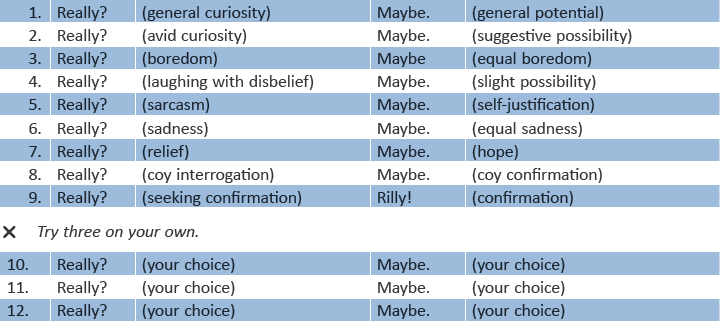
Review Exercise 13: Who Did It? I Don’t Know! |
Repeat the following statements and responses expressing the various feelings.
1. |
Who did it? (curiosity) |
I don’t know. (ignorance) |
2. |
Who did it? (interrogation) |
I don’t know. (self-protection) |
3. |
Who did it? (anger) |
I don’t know. (insistence) |
4. |
Who did it? (repeating) |
I don’t know. (strong denial) |
5. |
Who did it? (sarcasm) |
I don’t know. (self-justification) |
6. |
Who did it? (sadness) |
I don’t know. (despair) |
7. |
Who did it? (relief) |
I sure don’t know. (blithe ignorance) |
8. |
Whooo did it? (coy interrogation) |
I don’t know. (singsong) |
9. |
Who did it? (annoyance) |
I don’t know. (equal annoyance) |
10. |
Who did it? (laughing with disbelief) |
I don’t know. (laughing ignorance) |
11. |
Who did it? (surprise) |
I dunno. (sullenness) |
12. |
Who did it? (your choice) |
I don’t know. (your choice) |
Review Exercise 14: Russian Rebellion |
Rәshәz әfensәv әgεnst rebәlz in thә brεikәway reejәnәv Chechnyә iz entering ә nyu fεiz. än thә wәn hænd, Rәshәn forsәzr teiking fül kәntrol әv thә Rәshәn kæpәdәl, Gräzny, әnd Mäskæo sez thә wor seemz tә be trning in its feivr. än thee әthr hænd, thә rebәlz küd be reetreeding Gräzny jәst tә fight әnәthr day—enshring ә läng grrilә wor. Thә for-mәnth känflikt täpt thee әjendә tәdäy during Sεkrәtεry әv State Mædәlin älbräit’s täks with ækting Rәshәn prezәd’nt Vlædәmir Putin, älbräit then left fr Kro(w)εishә, әbæot which we will hear more shortly. Bәt frst, we trn tә thә Wrldz Nenet Shevek in Mäskæo.
olbräit εn Pu-tin met feu l nger thεn plennd tәday—feu nillee three äwεz. äftә thεә t
nger thεn plennd tәday—feu nillee three äwεz. äftә thεә t ks, olbrait k
ks, olbrait k ld thε meeting intens, bәt plεznt, εn
ld thε meeting intens, bәt plεznt, εn  feud this εsεsmεnt εf Rәshәz εkting prezidεnt.
feud this εsεsmεnt εf Rәshәz εkting prezidεnt.
I fæond him ә very wellin formd persәn. Heez äveeәslee ә Rәshәn paytreeәt әn älso sәmwәn who seeks a normәl pәzishәn fr Rәshә within thә West—әn he strәck me әzә präblәm sälvr

Russia’s offensive against rebels in the breakaway region of Chechnya is entering a new phase. On the one hand, Russian forces are taking full control of the Russian capital, Grozny, and Moscow says the war seems to be turning in its favor. On the other hand, the rebels could be retreating Grozny just to fight another day—ensuring a long guerilla war. The four-month conflict topped the agenda today during Secretary of State Madeline Albright’s talks with acting Russian president Vladimir Putin. Albright then left for Croatia, about which we’ll hear more shortly. But first, we turn to the World’s Nennet Shevek in Moscow.
“Albright and Putin met for longer than planned today—for nearly three hours. After the talks, Albright called the meeting intense, but pleasant, and offered this assessment of Russia’s acting president.”
“I found him a very well-informed person. He’s obviously a Russian patriot and also someone who seeks a normal position for Russia within the West—and he struck me as a problem solver.”
TWO-WORD PHRASES
Exercise A–M are a synopsis of all intonation patterns that have been studied so far.
Review Exercise A: Contrasting Descriptive and Set Phrases |
(Here we are reprising the exercise from Exercises 1-39 to 1-52.) To review, an adjective and a noun make a descriptive phrase, and the second word is stressed. Two nouns make a compound noun, or set phrase, and the first word is stressed. Repeat the following sentences. Copy your descriptive phrases and set phrases from Exercise 1-46. You will continue using these word combinations throughout this series of exercises. (See also Chapter 1.)
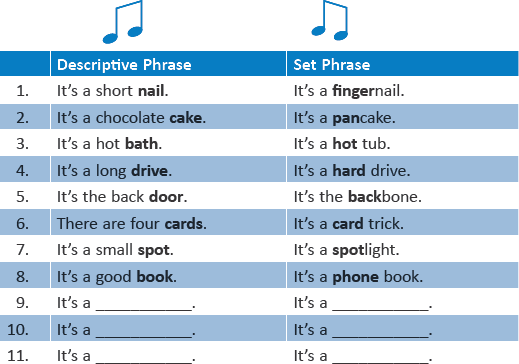
Review Exercise B: Intonation Review Test |
Put an accent mark over the word that should be stressed.
They live in Los Angeles. |
|
Give me a paper bag. |
|
Is that your lunch bag? |
|
7-11 is a convenience store. |
|
Lucky’s is a convenient store. |
|
Do your homework! |
|
He’s a good writer. |
|
It’s an apple pie. |
|
It’s a pineapple. |
|
We like all things. |
|
We like everything. |
|
It’s a moving van. |
|
It’s a new paper. |
|
It’s the newspaper. |
|
The doll has glass eyes. |
|
The doll has eyeglasses. |
|
It’s a high chair. |
|
It’s a highchair. (for babies) |
|
It’s a baseball. |
|
It’s a blue ball. |
THREE-WORD PHRASES
Review Exercise C: Modifying Descriptive Phrases |
When you modify a descriptive phrase by adding an adjective or adverb, you maintain the original intonation pattern and simply add an additional stress point.
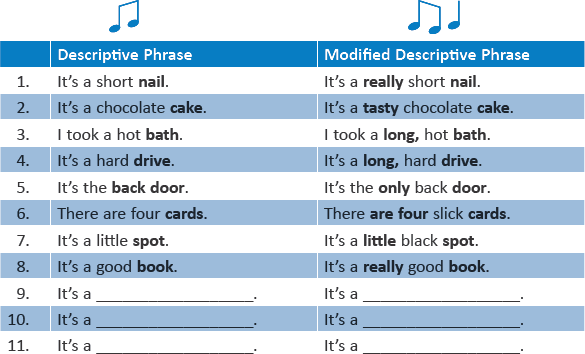
Review Exercise D: Modifying Set Phrases |
When you modify a set phrase, you maintain the same pattern, leaving the new adjective unstressed.
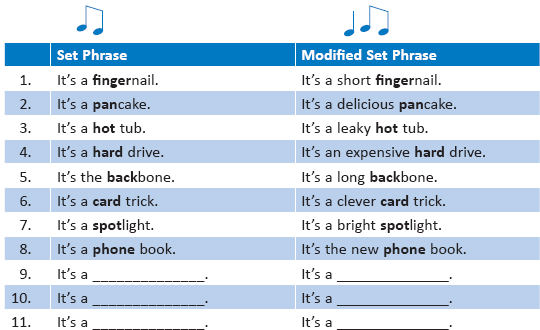
Review Exercise E: Two- and Three-Word Set Phrases |
You should be pretty familiar with the idea of a set phrase by now. The next step is when you have more components that link together to form a new thing—a three-word set phrase. Combine three things: finger + nail + clipper. Leave the stress on the first word: fíngernail clipper. Although you are now using three words, they still mean one new thing. Write your own sentences, using the word combinations from the previous exercises.
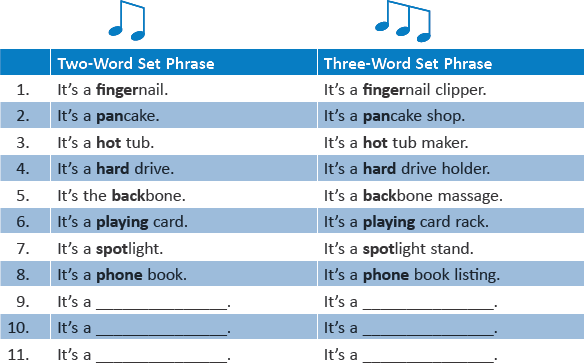
Review Exercise F: Three-Word Phrase Summary |
Repeat the following sentences. Write your own sentences, carrying over the same examples you used in the previous exercise.
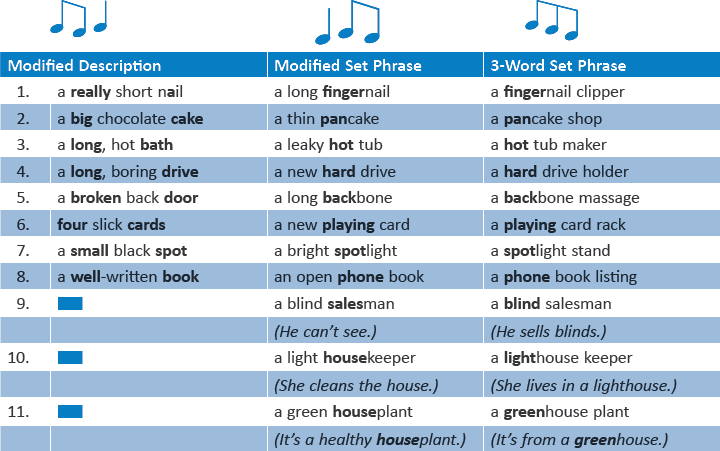

Review Exercise G: Three-Word Phrases—Three Little Pigs |
Notice where there are patterns, where the words change but the rhythm stays the same (straw-cutting tools, woodcutting tools, bricklaying tools). Read the story aloud.
Once upon a time, there were three little pigs. They lived with their kind old mother near a large, dark forest. One day, they decided to build their own houses. The first little pig used straw. He took his straw-cutting tools and his new lawnmower and built a little straw house. The second little pig used sticks. He took his woodcutting tools and some old paintbrushes and built a small wooden house. The third little pig, who was a very hard worker, used bricks. He took his bricklaying tools, an expensive mortarboard, and built a large brick house. In the forest lived a big bad wolf. He wanted to eat the three little pigs, so he went to the flimsy straw abode and tried to blow it down. “Not by the hair of my chinny chin chin!” cried the three little porkers. But the house was not very strong, and the big bad beast blew it down. The three little pigs ran to the rickety wooden structure, but the big bad wolf blew it down, too. Quickly, the three little piggies ran to the sturdy brick dwelling and hid inside. The big bad wolf huffed and he puffed, but he couldn’t blow the strong brick house down. The three little pigs laughed and danced and sang.
Review Exercise H: Sentence Balance—Goldilocks |
One of the most fascinating things about spoken English is how the intonation prepares the listener for what is coming. As you know, the main job of intonation is to announce new information. However, there is a secondary function, and that is to alert the listener of changes down the road. Certain shifts will be dictated for the sake of sentence balance. Set phrases and contrast don’t change, but the intonation of a descriptive phrase will move from the second word to the first, without changing the meaning. The stress change indicates that it’s not the end of the sentence, but rather, there is more to come. This is why it is particularly important to speak in phrases instead of word by word.
When we practiced Goldilocks and the Three Bears the first time, we had very short sentences, so we didn’t need sentence balance. All of the blue descriptive phrases would otherwise be stressed on the second word if the shift weren’t needed.
There is a little girl called Goldilocks. She is walking through a sunny forest and sees a small house. She knocks on the door, but no one answers. She goes inside to see what’s there. There are three chairs in the large room. Goldilocks sits on the biggest chair. It’s too high for her to sit on. She sits on the middle-sized one, but it’s too low. She sits on the small chair, and it is just right. On the table, there are three bowls of porridge. She tries the first one, but it is too hot to swallow. The second one is too cold, and the third one is just right, so she eats it all. After that, she goes upstairs to look around. There are three beds in the bedroom.
She sits down on the biggest one. It’s too hard to sleep on. The middle-sized bed is too soft. The little one is just right, so she lies down and falls asleep.
In the meantime, the family of three bears comes home—the Papa bear, the Mama bear, and the Baby bear. They look around and say, “Who’s been sitting in our chairs and eating our porridge?” Then they run upstairs and say, “Who’s been sleeping in our beds?” Goldilocks wakes up when she hears all the noise and is so scared that she runs out of the house and never comes back.
FOUR-WORD PHRASES
Review Exercise I: Multiple Modifiers with Set Phrases |
When you continue to modify a set phrase, you maintain the original intonation pattern and simply add an additional stress point.
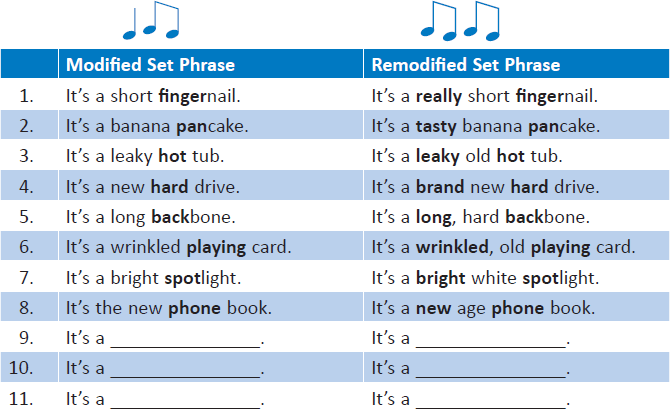
Review Exercise J: Compound Intonation of Numbers |
In short phrases (#1 and #2), –teen can be thought of as a separate word in terms of intonation. In longer phrases, the number + –teen becomes one word. Repeat after me.

Review Exercise K: Modifying Three-Word Set Phrases |
When you continue to modify a set phrase, you maintain the original intonation pattern and simply add an unstressed modifier.
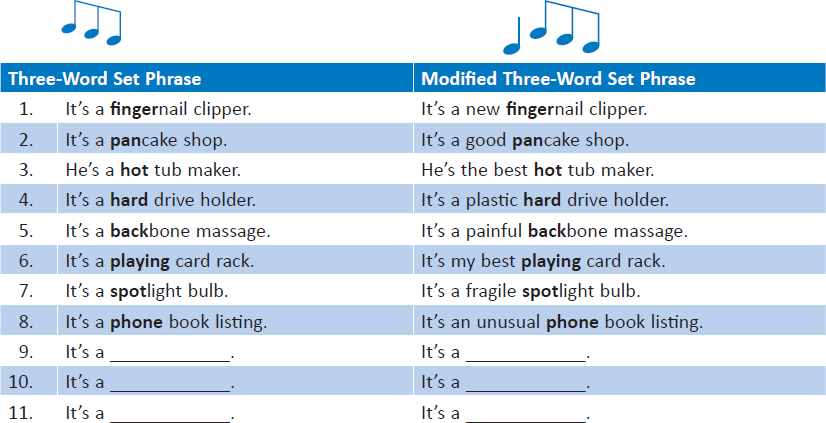
Review Exercise L: Four-Word Phrase Story—Little Red Riding Hood |
Repeat after me.
Once upon a time, there was a cute little redhead named Little Red Riding Hood. One day, she told her mother that she wanted to take a well-stocked picnic basket to her dear old grandmother on the other side of the dark, scary Black Forest. Her mother warned her not to talk to strangers—especially the dangerous big bad wolf. Little Red Riding Hood said she would be careful, and left. Halfway there, she saw a mild- mannered hitchhiker. She pulled over in her bright red sports car and offered him a ride. Just before they got to the freeway turnoff for her old grandmother’s house, the heavily bearded young man jumped out and ran away. (Was he the wolf?) He hurried ahead to the waiting grandmother’s house, let himself in, ate her, and jumped into her bed to wait for Little Red Riding Hood. When Little Red Riding Hood got to the house, she was surprised, “Grandmother, what big eyes you have!” The wolf replied, “The better to see you with, my dear . . .” “But Grandmother, what big ears you have!” “The better to hear you with, my dear . . .” “Oh, Grandmother, what big teeth you have!” “The better to eat you with!” And the wolf jumped out of the bed to eat Little Red Riding Hood. Fortunately for her, she was a recently paid-up member of the infamous National Rifle Association so she pulled out her brand new shotgun and shot the wolf dead.
Review Exercise M: Building Up to Five-Word Phrases |
Repeat after me, then write your own phrases, using the same order and form.
1. |
It’s a pot. |
noun |
2. |
It’s new. |
adjective |
3. |
It’s a new pot. |
descriptive phrase (noun) |
4. |
It’s brand new. |
descriptive phrase (adjective) |
5. |
It’s a brand new pot. |
modified descriptive phrase |
6. |
It’s a teapot. |
two-word set phrase |
7. |
It’s a new teapot. |
modified set phrase |
8. |
It’s a brand new teapot. |
modified set phrase |
9. |
It’s a teapot lid. |
three-word set phrase |
10. |
It’s a new teapot lid. |
modified three-word set phrase |
11. |
It’s a brand new teapot lid. |
modified three-word set phrase |
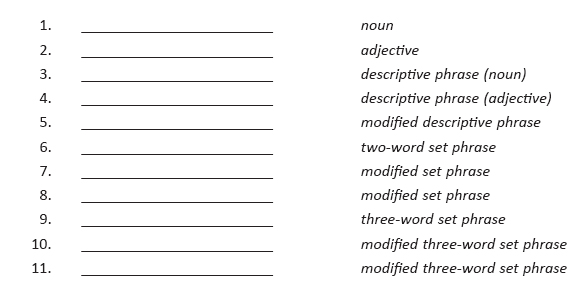
Since so many people are familiar with the binary system, let’s do a quick review of how complex intonation can be viewed with zeroes and ones.
pot |
1 |
new |
1 |
new pot |
01 |
brand new |
01 |
brand new pot |
101 |
teapot |
10 |
new teapot |
010 |
brand new teapot |
1010 |
teapot lid |
100 |
new teapot lid |
0100 |
brand new teapot lid |
10100 |
Do a global Search All and Replace for these patterns.
Review Exercise 15: Ignorance on Parade |
Now, let’s dissect a standard paragraph, including its title, as we did in Review Exercise 1. First—in the blue phrases in the first paragraph, decide which is a descriptive phrase, which is a set phrase, and where any additional stress might fall. Remember, descriptive phrases are stressed on the second word and set phrases on the first. Mark the stressed words. Second—go through the second paragraph and mark the remaining stressed words. Third—note where you think a short pause is appropriate in the third paragraph. In the last paragraph, change Ts to either a D or a held T, as needed. Listen as the speaker reads the paragraph. (See also Chapters 1 and 2.)
 Do the written exercises, including intonation; word groups; liaisons; æ, ä, ә; and the American T.
Do the written exercises, including intonation; word groups; liaisons; æ, ä, ә; and the American T.
1. Two-word phrases, intonation, and phrasing
Ignorance on Parade
You say you don’t know a proton from a crouton? Well, you’re not the only one. A recent nationwide survey funded by the National Science Foundation shows that fewer than 6 percent of American adults can be called scientifically literate. The rest think that DNA is a food additive, Chernobyl is a ski resort, and radioactive milk can be made safe by boiling. Judith Stone / 2109 Discover Publications
2. Word Connections
Ignoran sän Parade
You say you don’t know a proton from a crouton? Well, you’re not the only one. A recent nationwide survey funded by the National Science Foundation shows that fewer than 6 percent of American adults can be called scientifically literate. The rest think that DNA is a food additive, Chernobyl is a ski resort, and radioactive milk can be made safe by boiling.
3. æ, ä, ә
Ignәrәnce än Pәrade
You say you don’t know a proton from a crouton? Well, you’re not the only one. A recent nationwide survey funded by the National Science Foundation shows that fewer than 6 percent of American adults can be called scientifically literate. The rest think that DNA is a food additive, Chernobyl is a ski resort, and radioactive milk can be made safe by boiling.
4. The American T
Ignorants on Parade
You say you don’t know a proton from a crouton? Well, you’re not the only one. A recent nationwide survey funded by the National Science Foundation shows that fewer than 6 percent of American adults can be called scientifically literate. The rest think that DNA is a food additive, Chernobyl is a ski resort, and radioactive milk can be made safe by boiling.
Review Exercise 16: Ignorance on Parade Explanations |
Here, go over each topic, point by point.
1. Two-word phrases, intonation, and phrasing
a proton from a crouton? (contrast)
Well, you’re not the only one. (contrast)
A recent nationwide survey (modified descriptive phrase)
National Science Foundation (modified set phrase)
6 percent of American adults (descriptive phrase with sentence balance)
scientifically literate (descriptive phrase)
The rest think (contrast)
DNA (acronym)
food additive (set phrase)
ski resort (set phrase)
radioactive milk (descriptive phrase)
Ignorance on Parade(stop)
You say you don’t know a proton from a crouton? (pause) Well,(pause) you’re not the only one.(pause) A recent nationwide survey (pause) funded by the National Science Foundation (pause) shows that fewer than 6 percent of American adults (pause) can be called scientifically literate.(stop) The rest think(pause) that DNA is a food additive,(pause) Chernobyl is a ski resort,(pause) and radioactive milk(pause) can be made safe by boiling.
2. Word Connections
Ignoran sän Parade
You sa(y)you don(t)knowa proton froma crouton? Well, you’re no(t)the(y)only one. A recen(t)nationwidesurvey funded by the NationalSci(y)ence Foundation showzthat fewer thansix percen’v’merica nadults can be calledscientifically literate. The ressthink that Dee(y)εNA(y)iza foo dadditive, Chernobyliza ski resort, and radi(y)o(w)active milk can be madesafe by boiling.
3. æ, ä, ә
Ignәrәnce än Pәrade
You say you dont know ә protän frәm ә crootän? Well, yer nät thee(y)only wәn. ә resәnt nashәnwide srvey fәndәd by thә Næshәnәl Sci(y)әns Fæondashәn showz thәt fewәr thәn 6 pr senәv әmerәcәn әdәlts cәn be cälld sci(y)әntifәklee liderәt. Thә rest think thәt Dee Yeh Nay(y)izә food æddәtv, Chrnobl izә skee rәzort, әn radee(y)o(w)æctәv milk cәn be made safe by boiling.
4. The American T
Ignorants on Parade
You say you don(t) know a proTon from a crouTon? Well, you’re nä(t) the only one. A recen(t) nationwide survey funded by the National Science Foundation shows tha(t) fewer than 6 percen of American adulTs can be called scienTifically liderә(t). The ress think tha(t) DNA is a food addidive, Chernobyl is a ski resor(t), and radioakdiv milk can be made safe by boiling.
5. Combined
Ignәrәn sän Pәrade
You sa(y)you don(t)no wә protän frәmә crootän?(stop)Well,(pause)yer nät thee(y)only wәn. (pause)ә reesәn(t) nāshәnwide srvey(pause)fәndәd by thә Næshәnәl Sci(y)әns Fæondāshәn(pause)shoz thә(t) fewәr thәn 6 prcenә vәmerәcә nәdәlts(pause)cәn be cälld sci(y)әntifәklee liderәt.(stop)Thә ress think(pause)thә(t) Dee Yeh Nay(y)izә foo dæddәdv,(pause)Chrnobә lizә skee rәzort,(pause)әn raydee(y)o(w)æctәv milk(pause)cәn be made sāfe by boiling.
